Buddhism and Jainism | History for UPSC CSE PDF Download
Buddhism and Jainism began in India around the 6th century BCE. They were part of a major change in society when people started questioning the rituals, sacrifices, and caste divisions of the Vedic religion. Gautama Buddha and Mahavira, the founders of these religions, gave people a new way of thinking and living. Both religions taught simple and practical ideas—like non-violence (ahimsa), truth, self-control, and respect for all living beings. They focused on personal efforts to achieve peace and freedom from the cycle of birth and death. Buddhism and Jainism had a strong impact on Indian society. They helped shape Indian art, architecture, education, and culture. Their teachings also spread to other parts of Asia.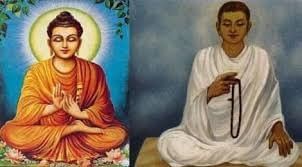 Buddhism and Jainism
Buddhism and Jainism
Origin of Buddhism
Buddhism started in India over 2,600 years ago as a way life that had the potential of transforming a person.
- It is one of the important religions of South and South-Eastern Asian countries.
- The religion is based upon the teachings, and life experiences of its founder Siddhartha Gautam, born circa 563 BCE.
- He was born into the royal family of the Sakya clan who ruled from Kapilvastu, in Lumbini which is situated near the Indo-Nepal Border.
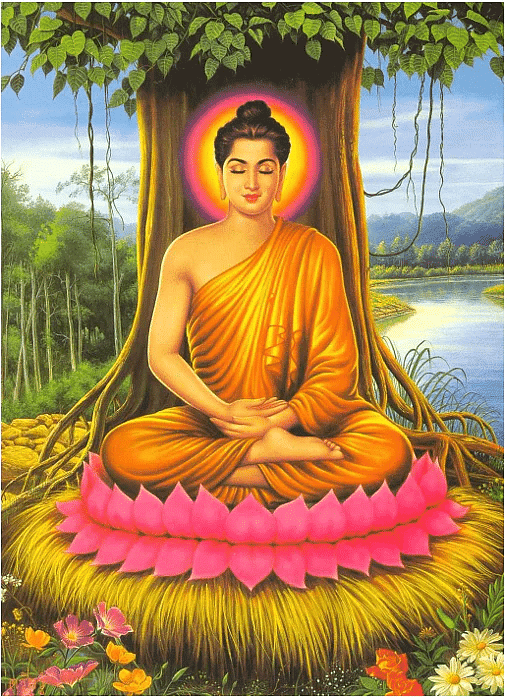 At the age of 29, Gautama left home and rejected his life of riches and embraced a lifestyle of asceticism or extreme self-discipline.
At the age of 29, Gautama left home and rejected his life of riches and embraced a lifestyle of asceticism or extreme self-discipline.- After 49 consecutive days of meditation, Gautama attained Bodhi (enlightenment) under a pipal tree at Bodhgaya a village in Bihar.
- Buddha gave his first sermon in the village of Sarnath, near the city of Benares in UP. This event is known as Dharma-Chakra-Pravartana (turning of the wheel of law).
- He died at the age of 80 in 483 BCE at a place called Kushinagara a town in UP. The event is known as Mahaparinibban.
Causes of Origin of Buddhism
- Favorable Temporal Context:
- Time Period: The 6th century B.C. provided a conducive environment for the spread of Buddhism.
- Public Discontent: During this time, people were disenchanted with superstitions, complex rituals, and blind beliefs.
- Buddha's Message: Siddhartha Gautam's teachings offered respite to those oppressed by the weight of Brahmanism.
- Simplicity of Doctrine:
- Arya Satya: Buddhism's doctrines, including the 'Arya Satya,' 'Eightfold Path,' and the concept of non-violence, were straightforward and accessible.
- Comparison to Jainism: Buddhism was perceived as simpler compared to Jainism, lacking the strictness of the latter and the complexity of Vedic ceremonies.
- Refreshing Shift: People fatigued with Brahminical manipulations found Buddhism to be a peaceful and refreshing departure.
- Simple Expressions:
- Prakrit Language: Buddha conveyed his message in the common vernacular, using the Prakrit language, which was the spoken language in India.
- Vs. Sanskrit: In contrast to the Brahmins' use of Sanskrit, a language not easily understood by the masses, Buddhism was communicated in a simple and comprehensible manner.
- Appealing Message: The simplicity of Buddhist philosophy and its appealing message persuaded people to embrace the new faith.
- Buddha's Endearing Personality:
- Kind and Selfless: Siddhartha Gautam's personal qualities, characterized by kindness and selflessness, endeared him and his teachings to the public.
- Moral Solutions: Buddha provided moral solutions to the problems faced by individuals, contributing to the rapid expansion of Buddhism.
- Inexpensive Religion: Buddhism was cost-effective as it lacked the elaborate and expensive rites associated with Vedic rituals.
- No Caste Discrimination:
- Anti-Caste: Buddhism rejected the caste system, treating people from all castes equally.
- Ethical Discussions: Followers of Buddhism, irrespective of their caste, engaged in discussions on ethics and morals.
- Non-Brahmin Attraction: The anti-caste stance of Buddhism particularly attracted those outside the Brahminical fold.
- Royal Support:
- Kshatriya Prince: Siddhartha Gautam, the Buddha, belonged to the Kshatriya (warrior) class, which facilitated the acceptance of Buddhism among the ruling elite.
- Supportive Kings: Kings like Prasenjit, Bimbisara, Ajatasatru, Asoka, Kanishka, and Harshavardhan provided crucial patronage to Buddhism, aiding its growth across India and beyond.
- Spread Beyond India: Asoka, in particular, played a role in spreading Buddhism beyond the borders of India, sending emissaries to propagate the faith.
- Influence of Universities:
- Role of Universities: Institutions like Nalanda, Taxila, Puspagiri, and Vikramsila played a pivotal role in disseminating Buddhist teachings.
- Student Attraction: Students from various regions, including foreign countries, were attracted to these universities and embraced Buddhism.
- Renowned Pilgrim: Hiuen Tsang, a famous Chinese pilgrim and student at Nalanda University, contributed significantly to the development and spread of Buddhism.
- Buddhist Monks and Sangha:
- Dedicated Monks: Prominent monks such as Ananda, Sariputta, Maudgalayana, Sudatta, and Upali were dedicated to the propagation of Buddhism.
- Ascetic Lifestyle: The exemplary ascetic lifestyles of Buddhist monks (bhikshu) and lay devotees (Upasakas) inspired increasing numbers of people to adopt Buddhism.
- Sangha Growth: The Buddhist 'Order' (Sangha) expanded its branches throughout India, attracting local populations.
- Buddhist Councils:
- Post-Buddha Period: After the passing of the Buddha, four Buddhist Councils were convened to preserve and propagate his teachings.
- Organized Efforts: These councils played a vital role in organizing and disseminating the Buddhist scriptures and doctrines, contributing to the spread of Buddhism in India.
Life of Gautama Buddha and Evolution of Buddhism
Gautama Buddha, the founder of Buddhism, was born in 567 BC at Lumbinivana in Kapilvastu within the Sakya Kshatriya clan.
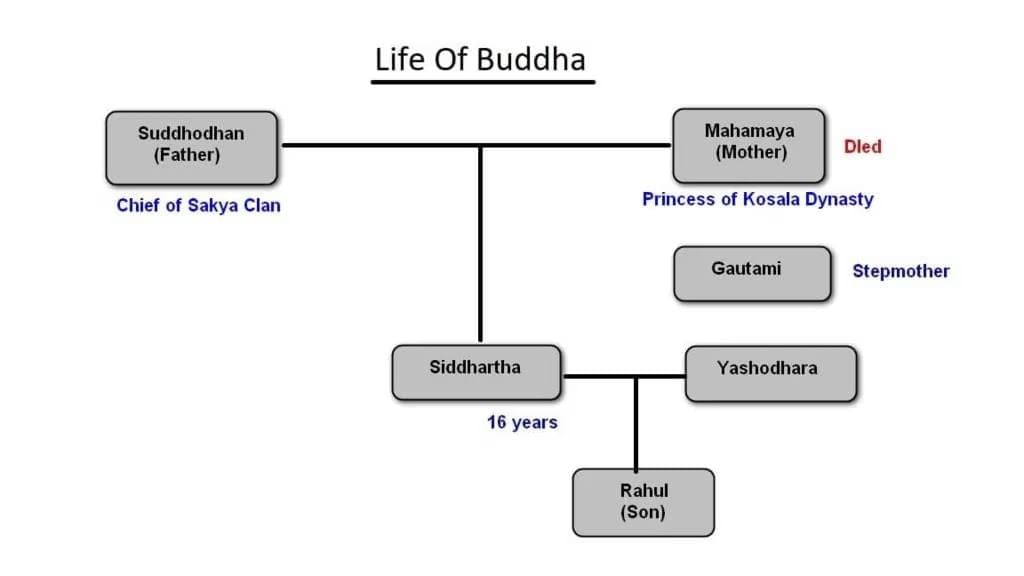
1. Family Background:
Gautama Buddha is also known as Shakyamuni. He was born into a Kshatriya Noble Family. He liked meditation from early age. He got married in an early age but he was never interested in marriage.
- Father: Suddodhana, king of Kapilvastu, headed the Shakya Clan.
- Mother: Mahamaya, princess of the Koshalan dynasty.
- Step Mother: Mahaprajapati Gautami.
- Wife: Yasodhara (Princess of the Koshalan dynasty).
- Son: Rahul.
2. Renunciation and Ascetic Life:
- Renounced home at age 29 (Mahabhinishkramana).
- Wandering ascetic life.
- Teachers: Alara Kalama and Udraka Ramputra.
3. Enlightenment:
- Attained Nirvana (enlightenment) at age 35 under a peepal tree at Uruvella (Bodh Gaya) on the bank of the river Niranjana (modern name Falgu) after 49 days of continuous meditation.
4. Key Events:
- The first sermon at Sarnath (Deer Park) is known as Dharmachakra Pravartana (Turning of the wheel of law).
- Famous disciples: Ananda and Upali.
- Rice milk is offered by Sujata, a farmer's daughter at Bodh Gaya.
- Passed away at age 80 in 483 BC at Kushinagar, known as Mahaparinirvana.
5. Eight Great Places Associated with Buddhism:
- Lumbini, Sarnath, Sravasti, Rajgriha, Bodh Gaya, Kushinagar, Sankisa, and Vaishali.
- Not associated: Patliputra.
6. Ashoka and Buddhism:
- Ashoka was the greatest patron of Buddhism.
- Called the 3rd Buddhist Council.
- Sent a mission led by his son Mahendra and daughter Sanghamitra to Sri Lanka.
7. Last Patrons of Buddhism: Palas of Bengal & Bihar were the last great patrons of Buddhism.
Events associated with Buddha’s life
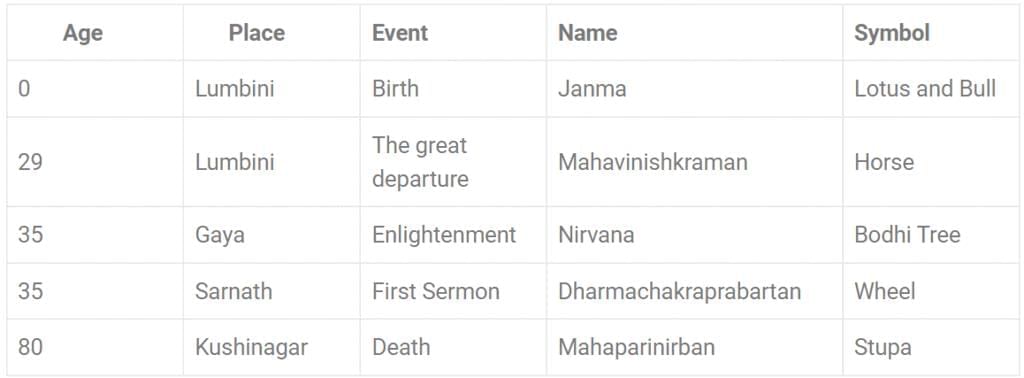
Doctrines of Buddhism
The core idea of the Doctrines of Buddhism is obtained from
1) Four Noble Truths: Ariya-Sachchani and
2) Eight-Fold Path: Astangika-Marga
Gautam Buddha’s teachings contain three important pillars:
- Buddha – Founder/ Teacher
- Dhamma – Teachings
- Sangha– Order of Buddhist monks/nuns (who act as torchbearers of Dhamma worshippers or Upasakas and are a major factor in the dissemination of the Buddha’s doctrine)
- While struggling for Enlightenment, Buddha had discovered Dhamma/Four Noble Truths
1) The Four Noble Truths
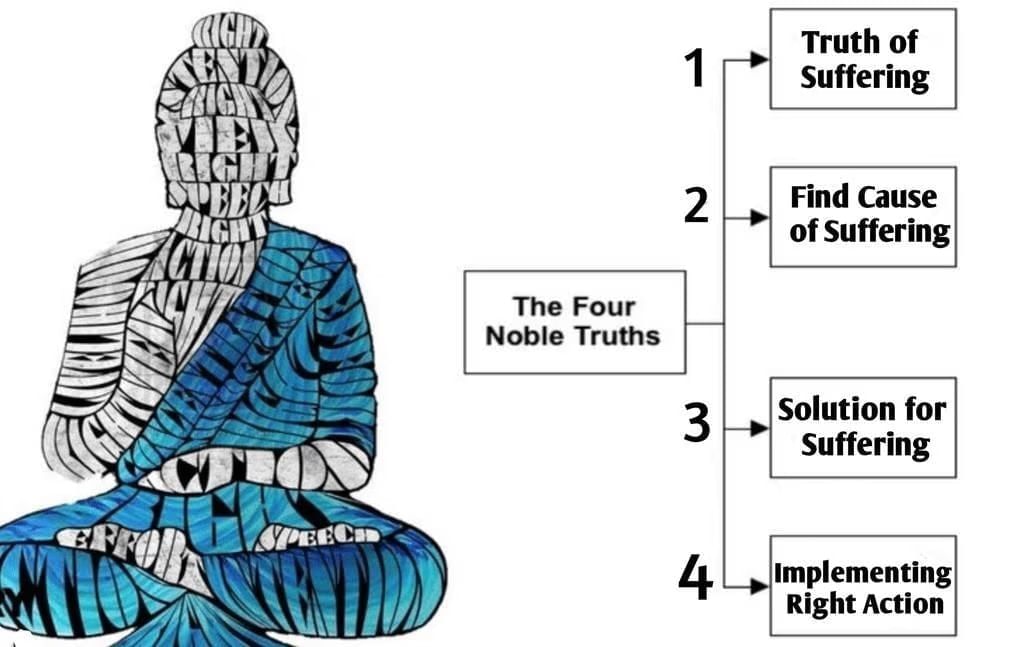
The four noble truths constitute the foundation of Buddhism's teachings:
- Suffering (Dukha): In Buddhism, "Sabbam Dukham" means that suffering is a part of everyone's life. It includes not just pain and sadness, but also shows how every person has the ability to go through tough times.
- Cause of Suffering (Samudaya): Buddhism says that the main reason for misery is Trishna, which means desire or wanting things. This idea is called the Truth of the Cause of Suffering. According to Buddhist teachings, all kinds of suffering happen for a reason and are a natural part of human life.
- End of Suffering (Nirodha): Buddhism teaches that Nibbana or Nirvana is the state where all suffering ends. When a person reaches this state, they are free from the continuous cycle of pain and problems.
- Path to the End of Suffering (Ashtangika-Marga): Buddhism explains that to stop suffering, one must follow the Eightfold Path. This path includes important rules and ways of living that help a person move towards a life without suffering.
2) Eight-Fold Path: (Astangika-Marga)
Eight-Fold Path is the practical guide to ethical and mental development leading to Nirvana.
The Eight-Fold Path is more about unlearning rather than learning, i.e., to learn in order to unlearn and uncover It is consisting of eight interrelated aspects, the path aids individuals in rising above conditioned responses that obscure their true nature. The Ashtanga-Marga encompasses:
 Eight Fold Path
Eight Fold Path
- Right Vision (Samma-Ditthi) – It is about understanding the nature of reality and the path of transformation.
- Right Thought or Attitude (Samma-Sankappa) – It signifies having emotional intelligence and acting from love and compassion.
- Right or Whole Speech (Samma-Vacca) – It signifies truthful, clear, uplifting and unharmful communications.
- Right or Integral Action (Samma-Kammanta) – It signifies an ethical foundation of life, on the principles of non-exploitation of oneself and others. It consists of five rules, which form the ethical Code of Conduct in Buddhism for the members of the monastic order and the laity. These are:
- Do not commit violence.
- Do not covet the property of others.
- Do not indulge in corrupt practices or sensual behaviour.
- Do not speak a lie.
- Do not use intoxicants.
- In addition to these, monks and nuns were strictly instructed to observe the following three additional precepts-
- To avoid eating after mid-day.
- To refrain from any sort of entertainment and use of ornaments to adorn oneself.
- To refrain from using high or luxurious beds, and from handling gold and silver (including money).
- Right or Proper Livelihood (Samma-Ajiva) – It lays emphasis on livelihood based on correct action and on the ethical principles of non-exploitation. It is believed that this forms the basis of an ideal society.
- Right Effort or Energy (Samma-Vayama) – It signifies consciously directing our life energy to the transformative path of creative and healing action that fosters wholeness thus moving towards conscious evolution.
- Right Mindfulness or Thorough Awareness ( Samma-Sati) – It means knowing one’s own self and watching self behaviour. There is a saying by the Buddha, “If you hold yourself dear, watch yourself well”.\
- Right Concentration or Meditation (Samma-Samadhi) – Samadhi literally means to be fixed, absorbed in. It means getting one’s whole being absorbed in various levels or modes of consciousness and awareness.
Major Buddhist Texts
The early Buddhist literature is divided into canonical and non-canonical texts:
1. Canonical texts:
These are believed to be the actual words of the Buddha. Canonical texts are books that lay down the basic tenets and principles of Buddhism such as the Tipitakas. Tipitaka
The earliest compilation of Buddhist teachings which were written on long, narrow leaves is “The Tipitakas” (in Pali) and “Tripitaka” (in Sanskrit).
- All the branches of Buddhism have the Tripitakas (also called three baskets/collections) as part of their core scriptures, which comprise three books which are:

- The Sutta: Traditional teachings of the Buddha.
- The Vinaya: Rules for discipline within the monastic community.
- The Abhidhamma: Study of the mind and ethics.
1. Sutta Pitaka – It consists of the main teaching or Dhamma of Buddha. It is divided into five Nikayas or collections:
(i) Dighgha Nikaya
(ii) Majhim Nikaya
(iii) Sanyukta Nikaya
(iv) Anguttar Nikaya
(v) Kshudraka Nikaya
2. Vinay Pitaka- This contains rules for monks and nuns of the monastic order (Sangha). It includes the Patimokkha – a list of transgressions against monastic discipline and atonements for these. The Vinaya text also includes doctrinal expositions, ritual texts, biographical stories and some elements of Jatakas or “birth stories”.
3. Abhidhamma Pitaka –The Abhidamma Pitaka is a philosophical analysis and systematization of the teaching and the scholarly activity of the monks. It consists of the religious and metaphysical discourses of Buddha
2. Non-canonical texts:
Non-Canonical or semi-canonical texts are commentaries and observations on canonical texts. Quotes, definitions, historical information, grammar and other writings in Pali, Tibetian, Chinese, and other East Asian languages. Some important ones are:
- Mahavastu (written in Sanskrit-Prakrit mixed) - it is about the sacred biography, i.e hagiography of the Buddha.
- Nidanakatha - the first connected life story of Buddha.
- The Dipavamsa & the Mahavamsa (both in Pali)- both give historical and mythical accounts of the Buddha's life, Buddhist Councils, Asoka and the arrival of Buddhism to Sri Lanka.
- Visuddhimagga (the path to purification written by Buddhaghosa) - deals with the development from the purity of discipline to enlightenment (Nibbana).
- Milindapanho (in Pali) - consists of a dialogue between the Indo-Greek king Milinda/Menander and the monk Nagasena on various philosophical issues. It is the only text in Sanskrit
- Nettipakarana (The book of guidance) - which gives a connected account of the Buddha's teachings.
Buddhist Councils
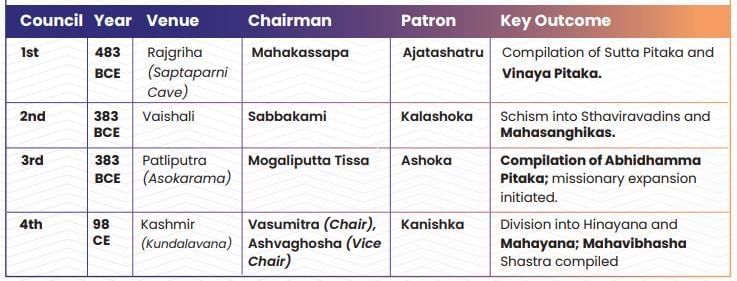 Buddhist Council
Buddhist Council
First Council
- The first Buddhist council was held at Rajgriha in 483 B.C. under the patronage of King Ajatshatru. It took place just after the death of Lord Buddha. Buddha's teachings were divided into three pitakas in the first council of Buddhism which was presided over by Monk Mahakasyapa. The compilation of Sutta Pitak and Vinay Pitak took place during this council.
Second Council
- It took place after 100 years of the death of Lord Buddha i.e. 383 in B.C. It took place in Vaishali under the patronage of King Kalashoka, it was presided by Sabakami. The spilt took place in this council on the issue of rules and discipline. As a result, two groups, Mahasanghika and Therivadi (Sthavirvadin) were formed.
Third Council
- It took place in Patliputra under the patronage of Ashoka. It was presided by Mogliputta Tisa. It is also known as the Council of Therivadins. “Katthavattu” was added to the Abhidhamma Patika during this council.
- However, none of the Ashokan inscriptions gives us information about the council.
Fourth Council
- Under the patronage of King Kanishka, It was held in Kundalgrama in Kashmir. The president of the council was Vasumitra and the vice president was Ashvagosha. Mahavibhasha, the doctrine of Sravastivadin was written in Sanskrit on a copper plate and enclosed in the stone boxes.
- During this council, the two sects of Buddhism i.e. Hinayana and Mahayana were formed officially.
Sects of Buddhism
Buddhism, with its rich and diverse history, has evolved into numerous sects and schools of thought over the centuries. Major sects include Hinayana, Mahayana, Vajrayana, and Zen, each with its unique features and philosophical underpinnings.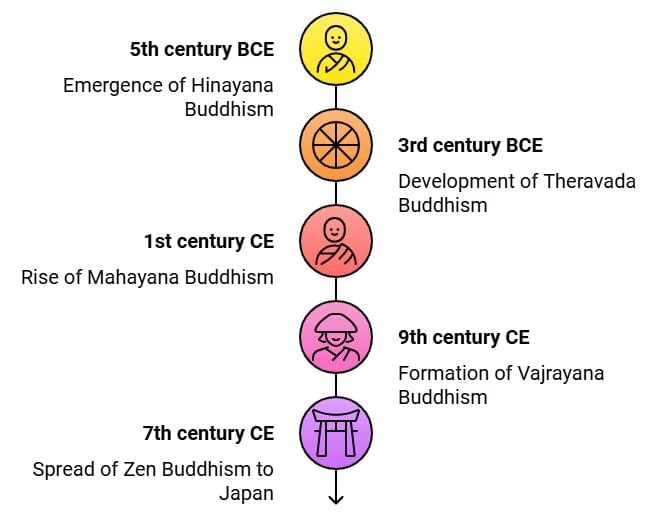
1. Hinayana (Lesser Vehicle)
Hinayana means "Lesser Vehicle" and is one of the early forms of Buddhism. It focuses on following Buddha’s original teachings closely.
- Main Beliefs: People aim to reach salvation (freedom from suffering) by being disciplined and meditating.
- Buddha's Role: Buddha is seen as a great teacher, not as a god. They do not worship idols.
- Language: Their texts are mainly written in Pali.
- Where It Spread: Also called Southern Buddhism, it is mostly followed in Sri Lanka, Myanmar (Burma), Thailand, and nearby areas.
- Sub-sects: Includes two main groups – Vaibhasika and Sautantrika.
2. Mahayana (Great Vehicle)
Mahayana, or the "Great Vehicle," represents a more expansive approach to Buddhism, focusing on universal salvation and the worship of the Buddha as a divine figure.
- Core Beliefs: Followers seek salvation for all beings through the grace of the Buddha and Bodhisattvas. Idol worship and devotion to celestial Buddhas are prominent.
- Literature: Key texts are primarily in Sanskrit.
- Geographical Spread: Known as the 'Northern Buddhist Religion,' it is prevalent in China, Korea, Japan, and other parts of East Asia.
- Sub-sects:
- Madhyamika (Shunyavada): Founded by Nagarjuna, focusing on the concept of emptiness.
- Yogacharya (Vijananavada): Founded by Maitreyanath and Asanga, emphasizing consciousness and perception.
3. Vajrayana (Diamond Vehicle)
Vajrayana, also known as Tantric Buddhism, emerged around 900 CE and incorporates esoteric practices and rituals.
- Core Beliefs: This tradition emphasizes the use of ritual and meditation techniques to achieve enlightenment swiftly. The Vajra (thunderbolt) symbolizes the power to overcome ignorance.
- Geographical Spread: Developed in Tibet and became prominent in Eastern India, especially Bengal and Bihar.
- Worship: Includes veneration of female deities and figures like Tara.
4. Theravada (Teaching of the Elders)
Theravada is a branch of Hinayana Buddhism and is the oldest and most traditional form. It follows the original teachings of the Buddha very strictly and carefully.
- Core Beliefs: Followers aim for personal salvation by strictly following Buddha’s teachings, focusing on discipline and meditation.
- View on Buddha: Buddha is seen as a great teacher, not a god. Idol worship is not followed.
- Literature: The main texts are written in Pali.
- Where It Spread: Also called Southern Buddhism, it is mainly practiced in Sri Lanka, Myanmar, Thailand, and nearby countries.
5. Zen (Chan)
Zen Buddhism, originating from the Chan school of Chinese Buddhism, emphasizes direct experience and meditation.
- Core Beliefs: Zen focuses on meditation (zazen) as the primary method for realizing one's inherent Buddha nature.
- Development: Spread from China to Japan in the 7th century CE.
- Distinctive Practice: Meditation is central, aiming for an intuitive understanding of enlightenment beyond intellectual study.
Each sect of Buddhism offers a distinct pathway to spiritual development, reflecting a rich diversity in practices and interpretations of the Buddha’s teachings.
Spread of Buddhism
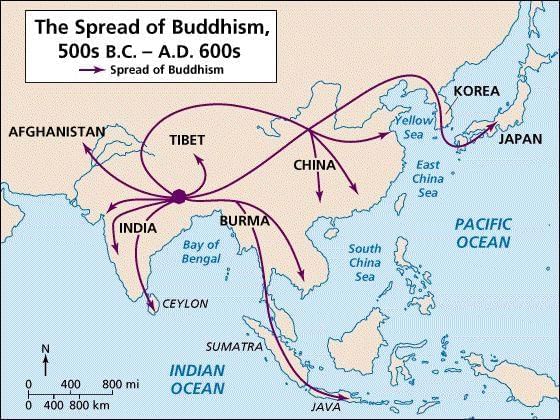 Spread of Buddhism
Spread of Buddhism
- Buddha had two kinds of disciples – monks (bhikshus) and lay worshippers (upasikas).
- The monks were organized into the Sangha to spread his teachings.
- The Sangha was governed on democratic lines and was empowered to enforce discipline among its members.
- Owing to the organised efforts made by the Sangha, Buddhism made rapid progress in North India even during Buddha’s lifetime.
- After the death of Buddha, his followers traversed his path of meditation and roamed throughout the countryside.
- For 200 years Buddhism remained overshadowed by their Hindu counterparts until the advent of Great Mauryan King – Ashoka.
- After the bloodbath in his Kalinga conquest, emperor Ashoka decided to give up the policy of worldly conquest and adopted the Dhamma conquest.
- Ashoka during the third Buddhist council dispatched various Buddhist missions to different areas such as Gandhara, Kashmir, Greece, Sri Lanka, Burma (Myanmar), Egypt, and Thailand.
- Through his missionary effort, Ashoka spread Buddhism into West Asia and Ceylon. Thus a local religious sect was transformed into a world religion.
Buddhism – Reasons for Decline
From the early 12th century, Buddhism began to disappear from the land of its birth. Various causes that led to the decline of Buddhism are:
- Corruption in Buddhist Sangha– Over time, the Buddhist Sangha became corrupt. The receipt of valuable gifts led them towards luxury and enjoyment, causing them to forget the principles set by Buddha. This shift marked the decline of the monks and their teachings.
- Division among Buddhists– Buddhism faced divisions from time to time. The division into various splinter groups like Hinayana, Mahayana, Vajrayana, Tantrayana and Sahajayana led Buddhism to lose its originality. The simplicity of Buddhism was lost and it was becoming complex.
- Use of Sanskrit language– Pali, the spoken language of most people of India, was the medium for the spread of the message of Buddhism. But Sanskrit replaced these at the Fourth Buddhist Council during the reign of Kanishka. Sanskrit was the language of a few intellectuals, hardly understood by the masses and therefore became one of the many reasons for the fall of Buddhism.
- Buddha worship– Image worship was started in Buddhism by the Mahayana Buddhists. They started worshipping the image of the Buddha. This mode of worship was a violation of the Buddhist principles of opposing complex rites and rituals of Brahmanical worship. This paradox led people to believe that Buddhism was tending towards the fold of Hinduism.
- Persecution of Buddhists– Over time there was the rise of the Brahmanical faith again. Some Brahmana rulers, such as Pushiyamitra Shunga, the Huna king, Mihirakula (worshiper of Shiva) and Shaivite Shashank of Gauda persecuted the Buddhists on a large scale. The liberal donations to the monasteries gradually declined. Also, some rich monasteries were specifically targeted by the Turkish and other invaders.
- Muslim invasion– The Muslim invasion of India almost wiped out Buddhism. Their invasions of India became regular, and repeated such invasions forced the Buddhist monks to seek asylum and shelter in Nepal and Tibet. In the end, Buddhism died away in India, the land of its birth.
Contribution of Buddhism to Indian Culture
Buddhism has made a remarkable contribution to the development of Indian culture:
- Ahimsa (Non-Violence): Buddhism strongly believed in ahimsa, meaning non-violence. This idea became an important part of Indian society, encouraging peace and kindness.
- Art and Architecture: Buddhism inspired beautiful art and buildings. Famous examples include the stupas at Sanchi, Bharhut, and Gaya, which show amazing Buddhist designs.
- Promotion of Education: Buddhism helped grow education by setting up great learning centers like Taxila, Nalanda, and Vikramasila. Students came from many regions to study there.
- Language Development: Buddhist teachings helped in the growth of the Pali language and other local languages, making Indian literature richer.
- Spread of Indian Culture: Buddhism helped carry Indian culture to many parts of Asia, creating cultural connections between different regions.
Buddhism as a Way of Soft Diplomacy
- Buddhism in India as a Soft Power is different from the conventional sense of the term. India talks about shared cultural development instead of the export of culture.
- The values of peace, accommodation, inclusiveness, and compassion that are part of our societies can be attributed to the influence of the teachings of Lord Buddha and Buddhism.
- The ideals of Buddhism continue to intersect with the political and economic contexts of many Asian nations with 22% of the world’s population.
- Buddhism can act as an intensifying factor for Asian emotional bonding and connectivity as it is embedded into their “nationalistic” thinking and actions.
- Buddhism is not restricted to Asia and has been able to generate a spiritual awakening elsewhere in the world and influence a stream of philosophical traditions the world over.
- India has in its favour at the moment an abundance of resources by way of pilgrimage sites, the presence of the Dalai Lama, and international goodwill, as well as the right intentions.
UNESCO Heritage Sites Related to Buddhism in India
- Archaeological Site of Nalanda Mahavihara, Nalanda, Bihar
- Buddhist Monuments at Sanchi, Madhya Pradesh
- Mahabodhi Temple Complex, Bodh Gaya, Bihar
- Ajanta Caves, Aurangabad, Maharashtra
Way Forward
- The effective revitalisation of the Nalanda University project and encouragement of Buddhist studies in well-established universities will bring the International community to a common platform.
- The promotion of Buddhist tourism reminiscent of the ‘Incredible India’ campaign is required to popularise India’s association with the faith internationally.
- The government faces the crucial challenge of effective execution. Buddhist diplomacy would go a long way in countering the rise of China, strengthening its relations with Asian countries, and helping it further down the path of its regional and global power ambitions.
Origin of Jainism
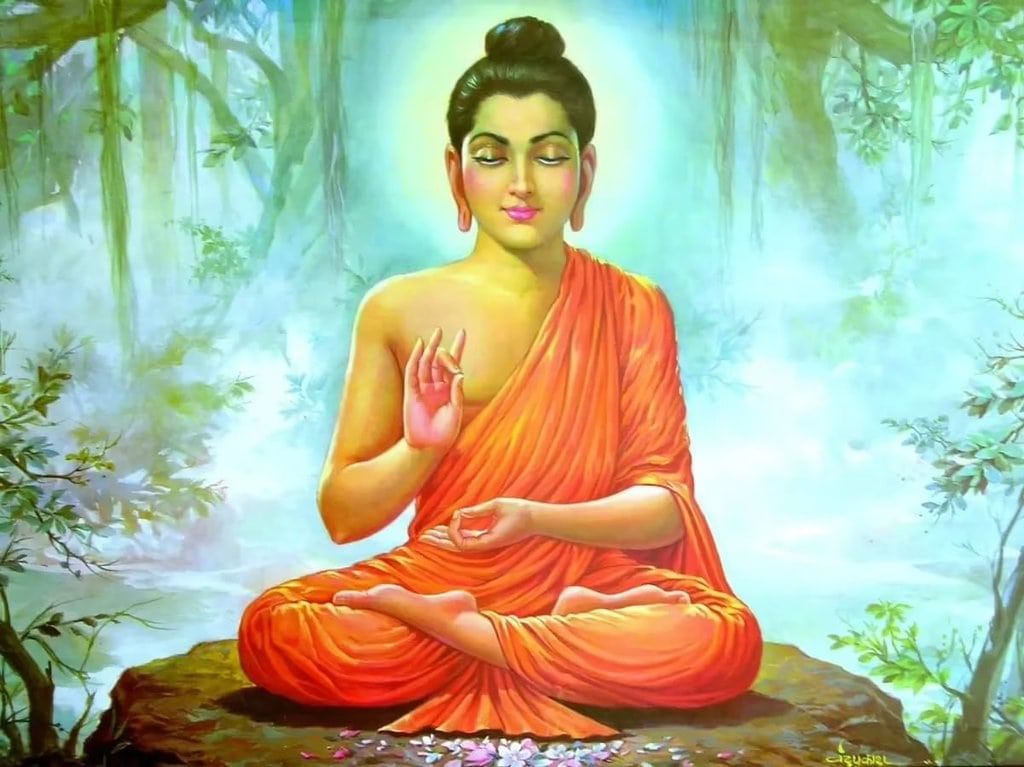 Founder of Jainism – Vardhaman Mahavira
Founder of Jainism – Vardhaman Mahavira
- Jainism is a very ancient religion. As per some traditions, it is as old as the Vedic religion.
- The Jain tradition has a succession of great teachers or Tirthankaras.
- There were 24 Tirthankaras the last of which was Vardhaman Mahavira.
- The first Tirthankara is believed to be Rishabhanath or Rishabhadev.
- The 23rd Tirthankara was Parshvanatha who was born in Varanasi. He may have lived in the 8th or 7th century BC.
- All the Tirthankaras were Kshatriyas by birth.
Founder of Jainism – Vardhaman Mahavira (539- 467 B.C.)
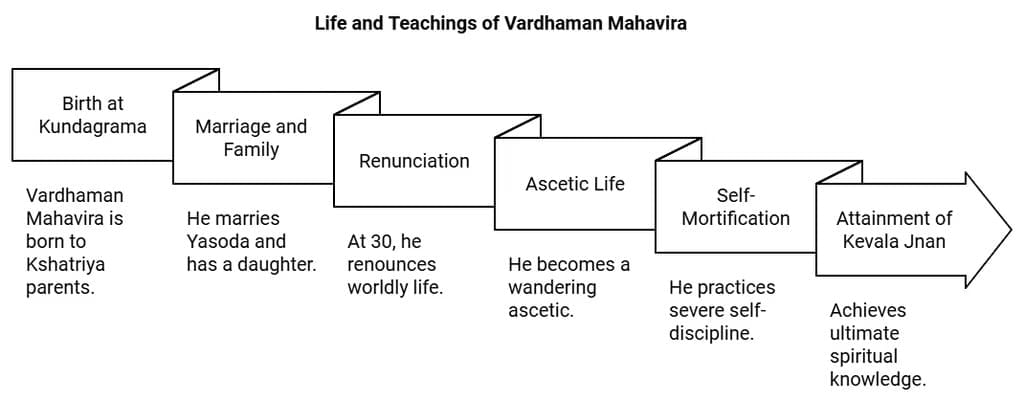
- Considered the last Tirthankara.
- He was born at Kundagrama near Vaisali.
- His parents were Kshatriyas. Father – Siddhartha (Head of Jnatrika Clan); Mother – Trishala (Sister of Lichchhavi chief Chetaka). (Chetaka’s daughter married Haryanka King Bimbisara).
- He was married to Yasoda and had a daughter Anojja or Priyadarsana.
- At the age of 30, Vardhaman renounced his home and became a wandering ascetic.
- He also observed self-mortification.
- After 13 years of penance, he attained the highest spiritual knowledge called Kevala Jnan. He attained this at Jimbhikagrama village under a sal tree aged 42. This is called Kaivalya. Thereafter, he was called Mahavira, Jina, Jitendriya (one who conquered his senses), Nigrantha (free from all bonds), and Kevalin.
- He preached his teachings for 30 years and died at Pava (near Rajagriha) aged 72.
Causes of the rise of Jainism
- Vedic religion had become highly ritualistic.
- Jainism was taught in Pali and Prakrit thus was more accessible to the common man as compared to Sanskrit.
- It was accessible to people of all castes.
- Varna system had rigidified and people of the lower castes led miserable lives. Jainism offered them an honourable place.
- About 200 years after the death of Mahavira, a great famine in the Ganga valley prompted Chandragupta Maurya and Bhadrabahu (last Acharya of the undivided Jain sangha) to migrate to Karnataka. Jainism spread to Southern India after that.
Teachings of Jainism
- Rejected the authority of the Vedas and opposed Vedic rituals.
- Did not believe in the existence of a creator God.
- Strongly believed in the law of karma and transmigration (rebirth) of the soul.
- Supported equality, but did not openly reject the varna system.
- Promoted a life of austerity (simple living) and non-violence (ahimsa).
Five Doctrines of Jainism (Panch Mahavrata)
Jainism teaches five main vows that guide a person’s moral and spiritual life:
- Ahimsa – Do not harm any living being (non-violence).
- Satya – Always speak the truth.
- Asteya – Do not steal or take anything without permission.
- Aparigraha – Do not hoard or collect unnecessary possessions.
- Brahmacharya – Practice self-control and celibacy.
Three Jewels of Jainism (Triratna)
The ultimate goal in Jainism is liberation (moksha), which means freedom from the cycle of birth and death. Rituals are not necessary to achieve this. Instead, liberation can be attained by following the Three Jewels:
- Right Faith (Samyak Darshana) – Having true belief in the teachings of Jainism.
- Right Knowledge (Samyak Jnana) – Understanding those teachings clearly and correctly.
- Right Conduct (Samyak Charitra) – Living a good life by following the path of truth and discipline.
Tirthankaras of Jainism
- Jainism recognizes 24 Tirthankaras, also known as "ford-makers," who help souls attain liberation from the cycle of birth and death.
- The Rig Veda mentions the names of two Tirthankaras: Rishabha and Arishtanemi.
- Mahavira, the 24th Tirthankara, introduced Brahmacharya (celibacy), thus completing the set of five major vows (doctrines) in Jainism.
 Important Tirthankaras
Important Tirthankaras
Split in Jainism
- When Bhadrabahu left for South India, Sthulabahu remained in the North with his followers.
- Sthulabahu changed the code of conduct and said that white clothes could be worn. Thus, split Jainism into two sects:
(1) Swetambaras: White-clad; Northerners
(2) Digambaras: Sky-clad (naked); Southerners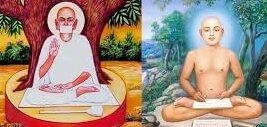 Swetambaras and Digambaras
Swetambaras and Digambaras
Digambara Sect (Sky-clad)
- Monks do not wear clothes as a symbol of complete renunciation. Female monks wear unstitched, plain white sarees.
- Strictly follow all five vows: Satya (truth), Ahimsa (non-violence), Asteya (non-stealing), Aparigraha (non-possession), and Brahmacharya (celibacy).
- Believe that women cannot achieve liberation in their current life; they must be reborn as men.
- Bhadrabahu was a key leader of this sect.
- Major sub-sects: Mula Sangh, Bisapantha, Terapantha, Taranpantha (also called Samaiyapantha).
- Minor sub-sects: Gumanapantha, Totapantha.
Shvetambara Sect (White-clad)
- Monks wear white clothes, symbolizing purity.
- Follow only four main vows, not including strict celibacy like Digambaras.
- Believe that women can attain liberation.
- Sthulabhadra was a key leader of this sect.
- Major sub-sects: Murtipujaka, Sthanakvasi, Terapanthi.
Tenets of Jainism
- Belief in God: Jainism accepts the existence of gods but considers them lower in status than the Jina (Mahavira). The Jina is the highest spiritual teacher.
- View on Varna System: Jainism did not reject the varna system completely but tried to reduce its negative effects and opposed the rituals of the Vedic religion.
- Theory of Karma and Rebirth: According to Mahavira, a person is born into a higher or lower varna based on the good or bad deeds (karma) of their past life. This belief reflects the ideas of transmigration of the soul and the law of karma.
Jainism – Jain Councils
 (i) First council
(i) First council- Held at Pataliputra in the 3rd century BC.
- Presided by Sthulabahu.
(ii) Second Council
- Held at Vallabhi in Gujarat in 512 CE.
- Presided by Devardhigani.
- 12 Angas was compiled here.
Royal patrons of Jainism
(i) South India
- Kadamba dynasty
- Ganga dynasty
- Amoghavarsha
- Kumarapala (Chalukya dynasty)
(ii) North India
- Bimbisara
- Ajatasatru
- Chandragupta Maurya
- Bindusara
- Harshavardhana
- Ama
- Bindusara
- Kharavela
Jain Architecture
Manastambha is an ornamental pillar placed in front of Jain temples. It holds the image of a Tirthankara on all four cardinal directions and has great religious importance, symbolizing humility before entering the temple. Manastambha- Ornamental Pillar(Jain Temples)Basadis are Jain temples or monastic establishments, especially found in Karnataka.
Manastambha- Ornamental Pillar(Jain Temples)Basadis are Jain temples or monastic establishments, especially found in Karnataka.
Layana or Gumphas (Caves): Several cave structures reflect Jain architectural influence. These include:
- The Ellora Caves (Cave Nos. 30 to 35) in Maharashtra
- The Mangi-Tungi Caves in Maharashtra
- The Gajapantha Caves in Maharashtra
- The Udayagiri and Khandagiri Caves in Odisha
- The Hathi-Gumpha Cave in Odisha
- The Sittanavasal Cave in Tamil Nadu
Statues associated with Jainism include:
- The Gomateshwara (Bahubali) statue at Shravanabelagola in Karnataka
- The Statue of Ahimsa (Rishabhanatha) at Mangi-Tungi Hills in Maharashtra
Prominent Jain Temples (Jainalayas) include:
- The Dilwara Temples at Mount Abu in Rajasthan
- The Girnar and Palitana Temple complexes in Gujarat
- The Muktagiri Temple in Maharashtra
Contribution of Jainism
- Jainism contributed significantly to Indian thought and culture.
- It preached the principle of non-violence (ahimsa) towards all living beings.
- The religion also contributed to the development of languages like Prakrit and Kannada.
- Mahavira, the 24th Tirthankara, preached in Ardha-Magadhi, the language of the common people.
- Jainism introduced the philosophical idea of Syadvada, which encourages multiple perspectives.
- It made a lasting impact on Indian art and architecture, with examples such as:
- the statue of Gomateshwara at Shravanabelagola,
- the temples of Khajuraho and Mount Abu,
- the Tiger Cave of Udayagiri, and
- Indra Sabha at Ellora.
- Additionally, Jainism supported the growth of trade and commerce and had a significant following among the trading community.
Decline of Jainism
- Absence of Royal Support – After the Mauryan period, most rulers supported either Buddhism or Hinduism instead of Jainism.
- Strict Lifestyle – Jainism’s severe ascetic practices made it difficult for common people to follow.
- Internal Divisions – The split between Digambaras and Shvetambaras caused internal conflicts and reduced collective strength.
- Philosophical Complexity – Jain doctrines were too complex for ordinary people to understand easily.
- Rise of Buddhism – Buddhism’s balanced “middle path” attracted more followers due to its simplicity and flexibility.
Comparison Between Jainism and Buddhism
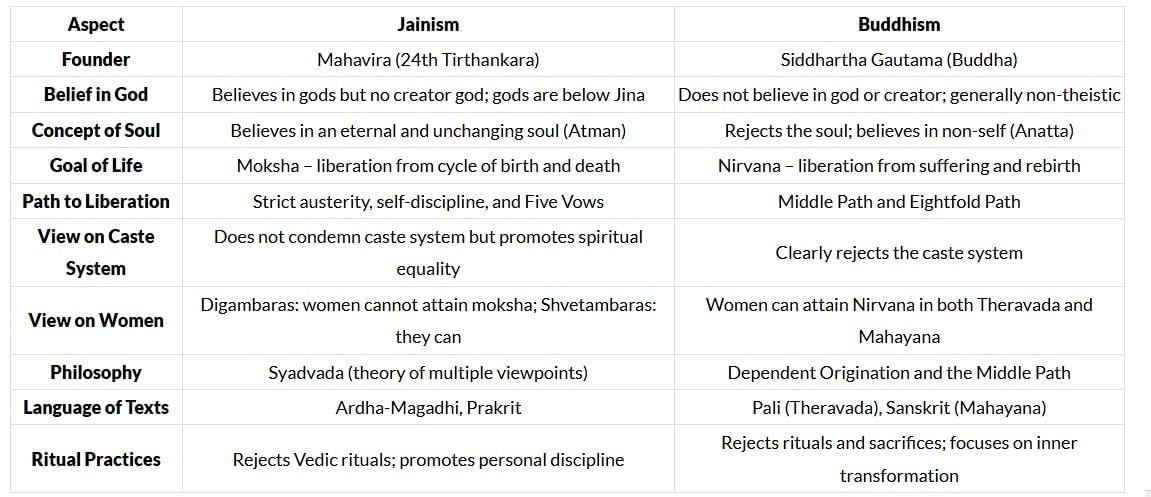
Similarities Between Jainism and Buddhism
- Jainism and Buddhism share many common elements.
- Both emphasize non-violence (ahimsa) as a central ethical principle.
- They believe in karma and the law of cause and effect.
- Both religions reject the caste system and support spiritual equality.
- They promote renunciation, asceticism, and a disciplined monastic life.
- Furthermore, both oppose the ritualistic and sacrificial practices of the Vedic religion.
- Each has a rich body of literature written in languages such as Sanskrit, Pali, and Ardha-Magadhi.
- Though Jainism and Buddhism developed in the same historical and cultural context, they follow distinct paths and philosophies toward spiritual liberation.
To practice questions of Buddhism, you can attempt the tests given below:
|
110 videos|653 docs|168 tests
|
FAQs on Buddhism and Jainism - History for UPSC CSE
| 1. What are the main teachings of Gautama Buddha in Buddhism? |  |
| 2. How did Buddhism spread beyond India? |  |
| 3. What are the major sects of Buddhism and how do they differ? |  |
| 4. What role did Buddhist councils play in the development of Buddhism? |  |
| 5. How did Buddhism contribute to Indian culture? |  |






















